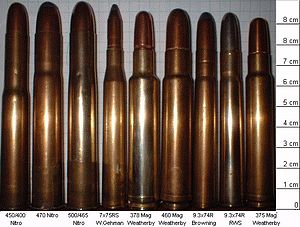The .378 Weatherby Magnum was designed by Roy Weatherby in 1953.[3][4] Although inspired by the .416 Rigby, it is an original belted magnum design with no parent case.[5] The cartridge features a high powder capacity relative to its bore size, and can hold upwards of 7.13 g (120 gr) of powder. This consideration prompted the Federal Cartridge Company to introduce the 215 Magnum primer specifically for this round.[5] The .378 shares the double radius shoulder design found on the other Weatherby magnum cartridges.
| .378 Weatherby Magnum | ||||||||||||||||||||||||
|---|---|---|---|---|---|---|---|---|---|---|---|---|---|---|---|---|---|---|---|---|---|---|---|---|
 .378 Weatherby Magnum, center | ||||||||||||||||||||||||
| Type | Rifle | |||||||||||||||||||||||
| Place of origin | South Gate, California | |||||||||||||||||||||||
| Production history | ||||||||||||||||||||||||
| Designer | Roy Weatherby | |||||||||||||||||||||||
| Designed | 1953 | |||||||||||||||||||||||
| Manufacturer | Weatherby | |||||||||||||||||||||||
| Produced | 1953-Present | |||||||||||||||||||||||
| Specifications | ||||||||||||||||||||||||
| Case type | Belted, bottleneck | |||||||||||||||||||||||
| Bullet diameter | .375 in (9.5 mm) | |||||||||||||||||||||||
| Neck diameter | .399 in (10.1 mm) | |||||||||||||||||||||||
| Shoulder diameter | .560 in (14.2 mm) | |||||||||||||||||||||||
| Base diameter | .582 in (14.8 mm) | |||||||||||||||||||||||
| Rim diameter | .579 in (14.7 mm) | |||||||||||||||||||||||
| Rim thickness | .063 in (1.6 mm) | |||||||||||||||||||||||
| Case length | 2.913 in (74.0 mm) | |||||||||||||||||||||||
| Overall length | 3.65 in (93 mm) | |||||||||||||||||||||||
| Rifling twist | 1 in 12 in (300 mm) | |||||||||||||||||||||||
| Primer type | Large rifle magnum | |||||||||||||||||||||||
| Ballistic performance | ||||||||||||||||||||||||
| ||||||||||||||||||||||||
| Test barrel length: 26 in (66 cm) Source(s): Weatherby [1] / Nosler [2] | ||||||||||||||||||||||||
The impetus for the development of the .378 arose from Roy Weatherby’s extensive field testing conducted in African hunting grounds. Based on his safari experiences, he believed it to be desirable to improve the performance afforded by his preexisting .375 Weatherby Magnum by devising a larger cartridge more in keeping with the design philosophy of his small-bore cartridges, such as his .300 and .257 Magnums.[6][7]
To promote the .378, Roy Weatherby killed an African elephant with one shot at extended range. In order to gain access to markets across the African continent by accommodating the 10.16 mm (.40 caliber) minimum bullet size required for use on dangerous game in some countries,[5] Weatherby soon necked the .378 to 11.63 mm (.458 caliber) and introduced the resultant cartridge as the .460 Weatherby Magnum in 1957.[8]
Considered a safari-grade cartridge, the .378 Weatherby Magnum is appropriate for taking all African game animals, including the African antelopes, Nile crocodile, hippopotamus, and the Big Five. Some hunters on the North American continent employ the .378 for American elk, brown bear, and polar bear. With proper bullet selection, the .378 provides a similar trajectory to and greater downrange energy than the .300 Winchester Magnum, .300 Weatherby Magnum, and .338 Lapua Magnum.
The .378 Weatherby generates considerable free recoil with full-power loads, for an average of 72 ft·lbf from a 9 lb rifle. This compares to 23 ft·lbf from a rifle chambered for .30-06 Springfield or 44 ft·lbf for the .375 H&H Magnum. However, the .458 Winchester Magnum generates 78 ft·lbf and the .458 Lott produces 86 ft·lbf of free recoil.[9] It should also be noted that Weatherby Mark V rifles chambered in this cartridge are equipped from the factory with removable muzzle brakes that greatly reduce felt recoil.
The .378 has been responsible for numerous wildcat cartridges. It has been necked-down as the .22 Eargesplitten Loudenboomer and necked-up as the .475 A&M and .500 A-Square, and shortened to produce the .30-378 Arch (7.62mm), .338-378 KT, and .460 Short A-Square (11.63mm).[10][11][12][13] Some .378-based derivatives have gone on to be part of the Weatherby line: namely, the .30-378, .338-378, .416 and .460.[14]
See also
edit- List of rifle cartridges
- 9 mm caliber other cartridges in the same caliber range.
- .22 Eargesplitten Loudenboomer
- .30-378 Weatherby Magnum
- .338-378 Weatherby Magnum
Footnotes
edit- ^ "Weatherby". Archived from the original on 2007-09-27. Retrieved 2018-11-26.
- ^ "Nosler". Archived from the original on 2007-09-28. Retrieved 2018-11-26.
- ^ FAQ at weatherby.com.
- ^ Jones, Allan (2021-04-05). "The .378 Weatherby Magnum". Shooting Times. Retrieved 2024-08-27.
- ^ a b c Any Shot You Want, The A-Square Handloading Manual, pp. 479,480
- ^ Sierra Bullets Reloading Manual, Rifle, Second Edition, pg.287
- ^ "weatherby". www.nrainsights.net. Archived from the original on 2007-09-28.
- ^ ":: Weatherby : .460 Weatherby Magnum ::". Archived from the original on 2008-08-08. Retrieved 2020-01-14.
- ^ Hornady Handbook of Cartridge Reloading (Tenth ed.). Grand Island, Nebraska: Hornady Manufacturing Company. 2016.
- ^ Ackley, P.O. (1927) [1962]. Handbook for Shooters & Reloaders. vol I (12th Printing ed.). Salt Lake City, Utah: Plaza Publishing. p. 442. ISBN 978-99929-4-881-1.
- ^ Any Shot You Want, The A-Square Handloading Manual, pg 604
- ^ Ackley, P.O. (1979) [1966]. Handbook for Shooters & Reloaders. vol II (8th Printing ed.). Salt Lake City, Utah: Plaza Publishing. p. 141. ASIN B000BGII48.
- ^ Any Shot You Want, The A-Square Handloading Manual, pg 561
- ^ "Weatherby Ammunition". Archived from the original on 2007-04-10. Retrieved 2007-04-01.